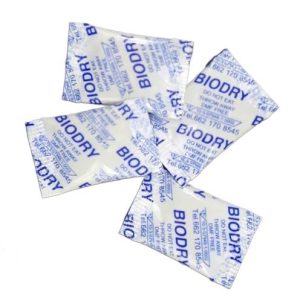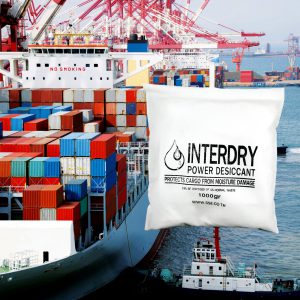Desiccant Calculator


Table of Content
Moisture control is different depending on what you’re protecting. A small box with electronics needs a very different desiccant plan compared to a full shipping container loaded with rice or auto parts.
This guide breaks everything into two clear sections so customers can choose the right calculator for their situation.
1️⃣ Desiccant Calculator for Small Packages, BioDry, and Silica Gel Sachets
Small packages behave very differently from container cargo. They have less air volume, heat up and cool down quickly, and are usually packed inside a carton or plastic bag. Because of this, the main goal is simple: keep the internal humidity low enough so that the product doesn’t absorb moisture.


Here’s what most people use:
BioDry Activated Clay
BioDry is designed for general-purpose moisture control inside cartons, shoe boxes, bags, electronics, dried foods, leather, coconut oil products, and exports that aren’t containerised.
Typical absorption values at 25°C:
- 16.8% at 20% RH
- 28.0% at 50% RH
- 50.5% at 90% RH
BioDry is strong at high humidity, so it’s a good fit for Thailand’s climate.
Silica Gel Sachets (White Silica Gel)
Silica gel is stable and works well when the target is low humidity.
Typical absorption values:
- 10–12% at 20% RH
- 23–27% at 50% RH
- 32–38% at 90% RH
Silica gel is ideal for:
- Electronics
- Medical tools
- Leather goods
- Photo equipment
- Collectibles and documents
For most customers, the only question is:
“How many grams do I need for my box or bag?”
Small Package Desiccant Calculator (Silica Gel / BioDry)
2️⃣ Desiccant Calculator for Shipping Containers and Cargo Transport
Moisture inside a shipping container is a completely different problem. Containers are large metal boxes that heat up during the day and cool down at night. This daily cycle causes condensation (“container rain”), mold growth, carton collapse, and corrosion.


The right desiccant can prevent all of that, but the required capacity is much higher than for small boxes.
This section helps customers calculate the correct quantity of:
- IPD InterDry Power Desiccant (calcium chloride, up to 300% absorption)
- Ecobag Activated Clay (50.5% absorption at 90% RH)
- Container-grade Silica Gel (1 kg bags, 32–38% absorption at 90% RH)
Below is a simple rule of thumb before using the calculator:
| Container Size | IPD | Ecobag | Silica Gel |
|---|---|---|---|
| 20 ft | 10–12 pcs | 12–16 pcs (500g–1kg) | 20–30 kg |
| 40 ft | 20–24 pcs | 24–32 pcs | 40–60 kg |
These numbers vary depending on:
- Moisture content of the cargo
- Duration of sea transport
- Origin/destination climate
- Ventilation tape sealing
The calculator will handle all these variables.
Container Desiccant Calculator
Final Notes for Customers
- Always seal ventilation holes in the container before loading. Also pay special attention that the doors are sealed when closing.
- Reduce loading time after hanging desiccants.
- For high-moisture cargo such as rice, coffee, tapioca, rubberwood, and paper rolls, always choose calcium-chloride-based IPD.
- For short transport or inland trucking, Ecobag or silica gel may be enough.
- For valuable cargo or long voyages, combine silica gel inside boxes and IPD inside the container.
Frequently Asked Questions
How does the Desiccant Calculator work?
The calculator estimates how much moisture is inside a package or container based on its volume, humidity, and the product you choose. It then compares this to the real absorption rate of each desiccant (Silica Gel, BioDry, IPD, or Ecobag) to give you the correct quantity.
What’s the difference between Silica Gel and BioDry?
Silica gel works best when the target humidity is low.
BioDry (activated clay) absorbs more moisture at high humidity, especially around 90% RH.
BioDry is usually better for Thailand’s climate, while silica gel is better when precise dryness is needed (electronics, medical tools).
Why does BioDry require fewer grams than Silica Gel?
Because it absorbs more moisture by weight.
At high humidity, BioDry absorbs about 50% of its weight, while silica gel absorbs around 35%.
The calculator adjusts automatically.
How do I measure the size of my box?
Measure the internal dimensions (length × width × height) in centimeters. Enter those into the calculator and it will convert the volume into liters automatically.
What humidity level should I select?
Use the environment where the product will be stored or transported:
Dry room: air-conditioned storage
Normal indoor: typical office or home
High humidity: Thailand warehouse, coastal areas
Very high humidity: kitchens, production rooms, unventilated storage
If unsure, select High humidity.
Are silica gel sachets and container silica gel the same?
They use the same type of beads, but the package size and intended use are different.
Small sachets are for boxes and cartons.
1 kg silica gel bags with hooks are for cargo containers.
This calculator handles both.
Does cargo type affect how much desiccant I need?
Yes. Some cargo, like rice, grain, wood, textiles, releases moisture during transport.
The container desiccant calculator includes cargo type so it can increase or decrease the recommended quantity automatically.
What is the absorption rate of IPD InterDry Power?
IPD is calcium chloride–based and absorbs up to 300% of its own weight.
This makes it the strongest option for shipping containers, especially for long voyages or high-moisture cargo.
Do I need to seal the ventilation holes in the container?
Yes. Always tape the vent holes from the inside before loading.
Leaving them open reduces the efficiency of desiccants and increases the risk of condensation and mold.
Can I mix different desiccant types?
Yes. Many exporters use BioDry or Silica Gel inside the product cartons, and IPD inside the container.
This provides two layers of protection and significantly reduces moisture problems during long transport.
See also our articles How much Silica Gel do I need? and How to Calculate the Quantity of Container Desiccant
ขอบคุณที่ใช้เวลาอ่านบทความของเราเกี่ยวกับการป้องกันความชื้น ทางเราหวังว่าท่านจะได้รับข้อมูลที่มีคุณค่าและเป็นประโยชน์ ทางเรายินดีให้บริการการปรึกษาฟรีเพื่อพูดคุยเกี่ยวกับความต้องการของท่านและให้คำแนะนำเกี่ยวกับวิธีการป้องกันความชื้นที่กำหนดเฉพาะสำหรับคุณ โปรดติดต่อเราที่ 0858124188 เพื่อนัดหมายการปรึกษาหรือเยี่ยมชมร้านค้าของเราเพื่อค้นหาผลิตภัณฑ์ที่ช่วยป้องกันสินค้าของคุณจากความเสียหายจากความชื้น ทางเราหวังว่าจะได้รับข่าวสารจากท่านเร็วๆนี้
